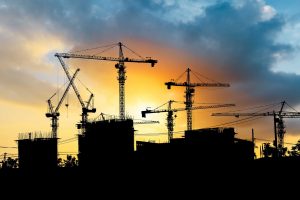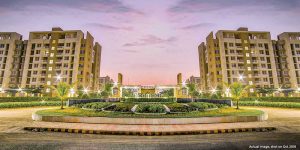Green building ecosystem

No challenge poses a greater threat to future generations than climate change
– President Barack Obama, State of the Union Address, 2015
In late 2015, representatives from 194 countries gathered in Paris for the 21st Conference of the Parties to the UN Framework Convention on Climate Change (or COP21 ). The signing of the Paris Agreement on climate change was hailed as a landmark deal that united a majority of nations around the world to commit to a better tomorrow.
Among the key outcomes achieved was the commitment to keep global temperatures ‘well below’ 2.0 C above pre-industrial times and to ‘endeavour to limit’ them even more, to 1.5 C; to limit the amount of greenhouse gases emitted by human activity to the same levels that trees, soil, and oceans can absorb naturally, beginning at some point between 2050 and 2100; and to review each country’s contribution to cutting emissions every five years..
Every country attending COP21 made a pledge to cut emissions. India, the fourth largest carbon-emitter in the world (accounting for 6% of total global emissions) agreed to reduce its carbon emissions intensity – emissions per unit of GDP – by 33-35% from 2005 levels, over 15 years. Similarly, China’s target is to reach peak CO2 emissions by 2030 at the latest.
Such targets are necessary if we want to secure a better planet for future generations. However, having agreed to these targets, it is even more important to identify the right focus areas and actions that would help achieve them. While emissions from industrial activity and vehicular traffic are the more ‘visible’ and top-of-mind targets for most, there is yet another sector which can contribute significantly to the reduction of greenhouse gases emissions – the construction sector.
Consider the estimates – globally, buildings account for approximately 40% of annual energy consumption and upto 30% of all energy-related greenhouse gas (GHG) emissions. Collectively, the building sector is responsible for about 40% of global resource use (including 12% of all fresh-water use) and produces up to 40% of solid waste. The sector also employs, on average, more than 10% of the workforce.
With rapid urbanization expected to continue in some of the world’s most populous countries, (the oft-repeated statistic that two-thirds of the India of 2030 is yet to be built is an indicator of the gargantuan scale), sustainable construction practices and green structures are no longer good-to-have; they are a key lever in our global war against emissions!
In the context of India, there are three essential steps to move towards an environment-friendly, sustainable future for the built environment-
1. Moving towards a ‘green’ portfolio: ensuring that all new buildings are certified based on existing green standards such as IGBC, GRIHA etc.
2. Identifying new materials, technologies and methods that improve the ‘green’ quotient: R&D led efforts that build on today’s basics of construction to drive improvements
3. Radically re-think the way we live: re-defining design and the way structures interact with the environment During their construction, occupancy, renovation, repurposing, and demolition.
1. Green portfolio
Today, there are well-established norms and processes that measure and certify how ‘green’ a structure is. From IGBC to GRIHA, there are multiple rating systems to guide, demonstrate and document efforts to deliver sustainable, high-performance buildings in India. Developers across categories – commercial, residential, retail and hospitality – are opting for green certification. GRIHA estimates that by 2022, registered green buildings will have 10 billion sq. ft. footprint. However, there is significant scope for scale, as only ~7% of registered projects are certified per GRIHA.
Widespread adoption of green building norms can significantly reduce emissions. In fact, The Energy Resources Institute estimates that if all buildings in urban India were to adopt green building concepts, we could reduce our power consumption by ~8,400 megawatts – enough to light 550,000 homes a year! Thus, there is a strong case to ensure that all future construction in the country is green – maybe even by mandating through legislation.
A very important aspect of green certifications is often overlooked – post-occupancy results. While the certifications process (with some exceptions) provides a framework based on theoretical benefits, the real benefits of various green features should be quantified to better understand their true impact. ‘Living Building Assessments’ are critical to demonstrate the benefits of, and put to scale, green certification adoption.
2. New materials and technologies
Even as green norms are adopted, leaders in sustainable development should invest in R&D to identify and develop materials, products and methodologies that pave the way for future improvements in resource utilization and emissions. This is especially true for India, since building guidelines are today largely based on international standards and methodology, and do not account for Indian usage and climatic conditions. For example, there has been limited work on thermal comfort, glare from daylighting & visual comfort specific to Indian circumstances. These have significant impact on cooling and artificial lighting requirements, which in turn impacts power usage and related emissions.
Given the scale and nature of this exercise combined with the fact that there is very limited R&D in the Indian construction sector, such an undertaking will necessarily have to adopt a multi-agency approach. It will need to combine the practical experience of developers with the research capabilities of educational and specialized institutes, together with inputs from construction materials manufacturers and service providers to the industry.
3. Innovation and radical design
Building construction is an ancient human activity which began with the purely functional need for a controlled environment to moderate the effects of climate. Constructed shelters were one of the means by which human beings were able to adapt themselves to a wide variety of climates and become a global species. The construction of buildings has necessitated the use of hard materials such as masonry, metals and glass, which create a barrier to the external environment. Such structures have not only impacted the way we interact with the environment, but also with each other. Most modern structures today need to use artificial means for everything – from lighting, cooling, heating, to storing and providing water, to bringing people together.
India has a rich history of architecture and construction that builds on natural phenomena and creates a symbiotic relationship between a structure and its surrounding environment. The use of step-wells as heat sinks, ‘jaalis’ as thermal buffers and natural materials such as stone, grass and reeds to reduce cost and environmental impact are just some of the examples of how architecture can achieve harmony with nature.
Globally too, architects such as Sou Fujimoto, Wang Shu, Thomas Herzog and Tatiana Bilbao have focused on the use of traditional methods and indigenous materials for construction. The Living Architecture (LIAR) project, for example, is envisioned as an integral component of human dwelling, capable of extracting valuable resources from sunlight, waste water and air and in turn, generating oxygen, proteins and biomass through the manipulation of their interactions. Its aim is to transform our habitats from inert spaces into programmable sites. As we expand our built environment, we should increasingly move away from uni-functional structures to ones that are open, permeable and interact with nature.
As with other sectors or industries, innovation in urban construction is likely to be increasingly technology-driven. However, we must always be cognizant of the one stakeholder at center of it all – the customer or end user. As the real estate and construction ecosystem makes the shift to greener development norms and practices buildings, it will be equally important to educate customers about the benefits– both to the environment in the form of lower emissions and to the customers via lower operating & maintenance costs! Until the supply of green buildings is complemented with demand, the battle will be only half won!
Authored blog post –
Vaibhav Jambhekar
SR. GM – STRATEGY & BUSINESS EXCELLENCE, STRATEGY
















